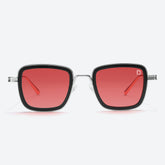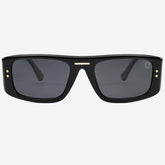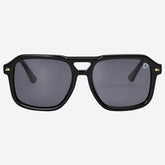What Are Trifocal Glasses? Clear Vision At Every Distance
Picture yourself: Switching glasses. When you're driving and when you're reading. It's hectic, right? As you age, vision correctness becomes a necessity. When you have different prescriptions, trifocal glasses are the perfect solution. Trifocals are multifocal glasses that offer different vision correction. It's like three different glasses combined into a single pair.
You can treat three different prescriptions efficiently with trifocal glasses. Trifocals remove the need of switching lenses between various tasks. The lens has physical lines separating different parts of it. The three portions of trifocals are responsible for treating nearsightedness, farsightedness, as well as intermediate vision.
Three focal points, one incredible view. Experience the magic of trifocals. Dig deep and find out what are trifocals for, how they improve vision, their advantages and disadvantages as well as what frames they can pair up with.

How Do Trifocals Work?
From close-up to far-away to anywhere in-between, trifocals keep your vision on-point. Trifocals normally have two lines on their lens. The upper portion of the lens corrects distant vision. The middle part of the lens corrects intermediate vision, and the lower portion opts for the correction of close-up vision.
There are some points to keep in mind while using your trifocals. Here are they
- Consult your optometrist when you get trifocal. They will teach you based on your prescription.
- Wear your trifocals all the time, except when you're asleep.
- When you're doing a task, focus on distant objects. Look through the upper portion of the lens.
- Adjust your trifocal glasses correctly. This will ensure vision correctness in the long run.
- Do not move the book while you read wearing trifocal glasses.
You can also get thinner and more sleek trifocals matching the fashion-forward trends. You need to shop for trifocal glasses very wisely. Break down the cost. You don't need to pay for features with no use. Visit Dollger eyeglasses to get the perfect budget-friendly aviator frames for your trifocal glasses.
Vision correction with trifocals

Trifocals are the opposite of single-vision lenses. Single-vision lenses focus on treating single-eyesight problems. Whereas trifocal, in a single prescription lens, treats blurry vision at three different distances – close, distant, and intermediate. Let's see what vision correction trifocal glasses offer.
Presbyopia:
Presbyopia is a common eye problem. It is related with age, when the natural lens of a person reduces its flexibility. It affects the person's ability to focus near objects. The lower part of the trifocal easily solves this issue. Trifocal glasses are effective in reducing eye strain, headaches, and blurred vision.
Myopia:
Myopia is the reduced ability of a person to focus on distant objects. This includes driving or looking at a whiteboard. Trifocals are effective in treating and reducing myopia.
Intermediate Vision:
Intermediate vision includes doing chores or tasks that are at an arm's length distance. You might only think about far or near visions. But intermediate vision is used quite often This includes looking at objects a few feet away. Looking at a cellphone or computer screen is an example of intermediate vision.
Trifocal advantages
Multiple Focal Points:
Who doesn't want efficiency and convenience? Trifocal glasses grant seamless work in switching the vocals. They carry three prescriptions in a single lens. The need to switch glasses for near, far, and intermediate clarity diminishes. Whatever your vision seeks, trifocal has it all.
Versatility:
Trifocal with aviator sunglasses offer versatility. Glasses with trifocal lenses correct your vision without compromising the aesthetics. Maintain the sleek, classy, and stylish aura with your eyewear. Dollger eyeglasses has the perfect frame for your trifocal.
No Switching Of Glasses:
The hassle of carrying and switching different glasses is aching. Trifocal glasses eliminate the need for multiple glasses.
Smooth Transitioning:
Minimised visual disturbance and discomfort ensure clarity. Once you adapt to trifocal glasses. The transition between near, far, and intermediate vision becomes smooth and hassle-free.
Cost:
Due to their specialised design and multifocal points, trifocal glasses are slightly expensive. Yet they're budget-friendly. The need for different frames and lenses with different focal distances eliminates. You get all three frames rolled into one trifocal lens. In this scenario, trifocal with aviator sunglasses wins it all.
Trifocal disadvantages
Visible Lines:
Trifocal glasses have a limitation. Which includes distraction. The visible two lines lengthen the adaptation period. People either exhaust themselves or question its aesthetic appeal.
Adaptation Period:
It takes a good amount of time for the wearer to adapt to the multifocal lenses. The adaptation period leads to temporary discomfort and visual disturbance. So you need to have patience while opting for trifocal glasses.
Limited Intermediate Zone:
It gets very challenging for the wearer to achieve optimal clarity with the intermediate zone. It gets narrowed down to a few cm. This poses some difficulty. But with regularity, one develops the habit.
Peripheral Distortion:
Trifocal with their clarity is remarkable. But with all the focus on the central visual field. The peripheral vision suffers slightly. Wearers might see blurred or curved lines instead of vertical ones across the sides.
Types of trifocals:
The best part about choosing trifocals is preferences. The wearers get to choose the type of trifocal glasses that best suits them. The variety of trifocals available have unique designs and characteristics. Choose the one that suits your visual needs and preferences. Let the trifocal glasses type from below be based on your requirements and lifestyle.
Flat-top trifocal lenses:

Flat-top trifocal glasses are also called D-segment glasses. The near and intermediate vision is secured in the D-shape portion of the trifocal lens below. This d-shaped portion below is for close-up vision correctness. The middle flat portion aims to correct intermediate vision. While the upper segment goes for distant vision. Flat-top trifocal glasses enhance peripheral vision and are easy to adapt.
Executive trifocal lenses:

Executive trifocal glasses differ from flat-top trifocals in their seamless transition. They offer the complete segment in a single prescription. Hard? Let us tell you how. The complete lower part provides visual clarity for nearsightedness. The middle segment completely corrects the intermediate. And the upper one for distant vision. This provides a broader range for vision correction.
Double-T trifocal lenses:

Double-D trifocal glasses as mentioned in their name have double Ds. The D-shaped portion below corrects myopia (nearsightedness). And the D above also clears the near vision. This lens corrects distant vision with the middle part of the trifocal lens. These trifocal glasses are also called occupational glasses. They are best for someone who does a lot of close-up work positioned above their head.
Which frame will combine with trifocals?

Trifocals with aviator sunglasses are a perfect match. Trifocal glasses need enough space to minimize optimal peripheral and central vision. Dollger eyeglasses are best in terms of comfort and style. Similarly, aviator sunglasses offer a large space for trifocal lenses. No visual clarity is compromised. These aviator sunglasses from Dollger allow for optimal placement of near, far, and intermediate regions. The different colors, finishes, and designs are elegant. Aviator sunglasses are versatile. They add a timeless touch to any look.
Why Dollger Eyeglasses?
We recommend visiting a Dollger for eyeglasses because we keep comfort and elegance hooked. The versatile aviator sunglasses with trifocal lenses offer zero distortion and wide, crisp, and clear vision. Adjustable nose pads and temple arms offer durability. Trifocal glasses are already a bit difficult to adapt. Dollger eyeglasses knows your struggle to manage three prescriptions. As a result, these aviator sunglasses provide a seamless transition for everyday use. Have the trifocal glasses with reliable vision correction without compromising style and elegance!
FAQs
Q What is the difference between trifocal and progressive lenses?
The difference between progressive and trifocal glasses is hard lines. Progressive lenses offer multiple focal points. They also have eamless transitioning. This means you can correct all vision issues such as myopia, presbyopia, and astigmatism. All without worrying about the lines. Progressive lenses are more aesthetic and offer a more uniform look while treating three different prescriptions.
Q Which is better: bifocal or trifocal lens?
Bifocals have two lens powers, they restore two visions – near and far. Whereas trifocal glasses offer three vision corrections – near, intermediate, and far. Intermediate vision is of great importance. Most of the day-to-day tasks include wearing trifocal glasses.
Q Who needs trifocal glasses?
Older folks with more complex vision usually wear trifocals. But trifocals are also worn by people with multiple vision prescriptions such as myopic, presbyopic, and astigmatic. So, if you have a vision that requires correction at different distances, trifocal glasses are for you.
Q What are the disadvantages of trifocal lenses?
Although trifocal glasses are designed to improve vision at multiple focal points. There are some limitations. The disadvantages of trifocal glasses include adaptation periods and visible lines. You have to give enough time for these trifocal lenses in aviator glasses to be familiar. Stay consistent, wear them often, and see how they ultimately solve all your vision problems.
Conclusion:
Trifocal glasses address the need of individuals with three different prescriptions ie. farsightedness, nearsightedness, and intermediate vision. The three portions on the lens have two lines. The upper one is for farsightedness, the middle one is for intermediate, and the lower one corrects nearsightedness. Types of trifocal glasses give you a variety of options. You can choose any of the trifocal based on your preference. But keep in head, that Dollger eyewear offers style and comfort with optimal vision correction. The aviator sunglasses with trifocal lenses are a game changer correcting vision at every glance. Click here to order now and experience the difference today!





